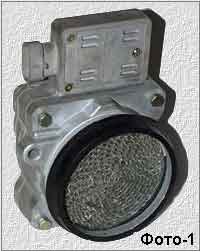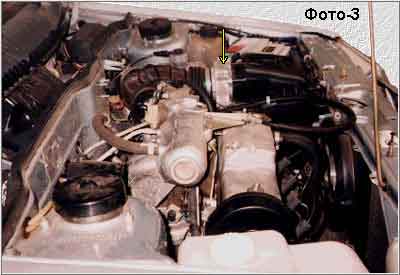
|
|
ENCYCLOPEDIA OF RADIO ELECTRONICS AND ELECTRICAL ENGINEERING Mass air flow sensor
Encyclopedia of radio electronics and electrical engineering / Automobile. Electronic fuel injection The mass air flow sensor (DMRV 2112-1130010) is a hot-wire type sensor (see photo 1) and outputs a pulse-frequency signal (2-10 kHz) to the controller, which varies in direct proportion to the amount of air passed through it.  The more air passed through the sensor, the higher the frequency of the DMRV signal. Accordingly, the amount of air passed through the sensor depends on the angular position of the throttle valve and the idle speed controller, through which air is supplied to bypass the throttle valve. By the frequency of the DMRV pulses, the controller judges the amount of air entering the engine and, accordingly, regulates the opening time of the fuel injectors, thus ensuring the necessary ratio of air and fuel in the fuel mixture. DMRV includes (see photo 2): 1. Filter retainer ring. 2. Filter. 3. Inlet flange. 4. Sealing rubber ring. 5. Sensor housing. 6. el charge. 7. Thermoelements. 8. Pin connector. 9. Outlet flange. 10. Screws for fastening elements.  Three thermoelements are used in the design of this sensor. One (central) is used to determine the temperature of its environment, and the other two heat the air to a predetermined temperature exceeding the ambient temperature. Mass airflow is determined by measuring the electrical power required to maintain a given temperature rise and converting this power into a pulse-frequency signal. The filter serves to prevent large particles from entering the sensor housing, which can damage the thermocouples. In addition, it acts as an air divider to ensure a uniform air flow. The filter is installed in the inlet flange and fixed with a retaining ring. Sealing rubber rings are installed on both sides of the sensor housing and serve to prevent air leakage. Particular attention should be paid to the O-ring between the sensor body and the outlet flange. If there is air leakage in this place, it may not be taken into account by the system, which will lead to a lean fuel mixture. In this case, it is almost impossible to ensure the optimal operation of the engine, because. the system "January-4" does not provide feedback on the lambda probe. It is rather problematic to identify air leakage without the use of a special multitester. The DMRV is installed (see photo 3) between the air filter and the air supply hose to the throttle body. To dismantle the DMRV, it is necessary to disconnect the connector with the ignition off, disconnect the air hose and unscrew the two bolts securing the sensor to the air filter. Installation should be carried out in the reverse order of dismantling.  The DMRV resource is not regulated and largely depends on the condition of the air filter. Foreign particles entering the sensor housing can damage it. In the event of malfunctions of the MAF, the error code "33" or "34" is stored in the RAM of the Electric Control Unit, which can be read using the "CHECK ENGINE" lamp in the code reading mode or with a special multi-tester. At the same time, this lamp lights up, and the controller calculates the air flow value from the signals from the throttle position sensor and the crankshaft position sensor. Symptoms of a malfunctioning DMRV can be an engine stop when shifting gears while the car is moving, engine failures under load and at idle. The "CHECK ENGINE" lamp, at the same time, often does not light up and it can be quite difficult to determine this malfunction with improvised means. When diagnosing a system, it is necessary to carefully study the nature of the engine operation in different modes and compare the response of sensors to a particular symptom. It can be recommended to follow the method of eliminating all possible causes with checking the relevant sensors. It should be borne in mind that the mass air flow sensor is an accurate measuring device and, as practice shows, is "afraid" of blows to the body. Publication: cxem.net
See other articles Section Automobile. Electronic fuel injection
Air trap for insects
01.05.2024 The threat of space debris to the Earth's magnetic field
01.05.2024 Solidification of bulk substances
30.04.2024
▪ site section Tools and mechanisms for agriculture ▪ magazines Repair of electronic equipment (annual archives) ▪ book amateur kumeter. Akmentynsh A.Ya., 1970 ▪ Del's article? Very simply: it is the money of others. Popular expression ▪ article Bonfires and hearths. Basics of safe life ▪ reference book Service menus of foreign TVs. Book #18
Home page | Library | Articles | Website map | Site Reviews www.diagram.com.ua |






 Arabic
Arabic Bengali
Bengali Chinese
Chinese English
English French
French German
German Hebrew
Hebrew Hindi
Hindi Italian
Italian Japanese
Japanese Korean
Korean Malay
Malay Polish
Polish Portuguese
Portuguese Spanish
Spanish Turkish
Turkish Ukrainian
Ukrainian Vietnamese
Vietnamese
 Leave your comment on this article:
Leave your comment on this article: